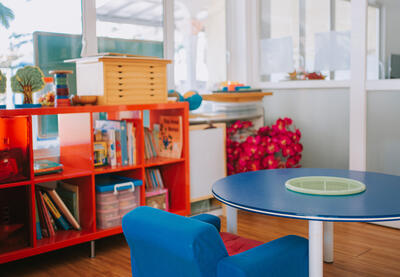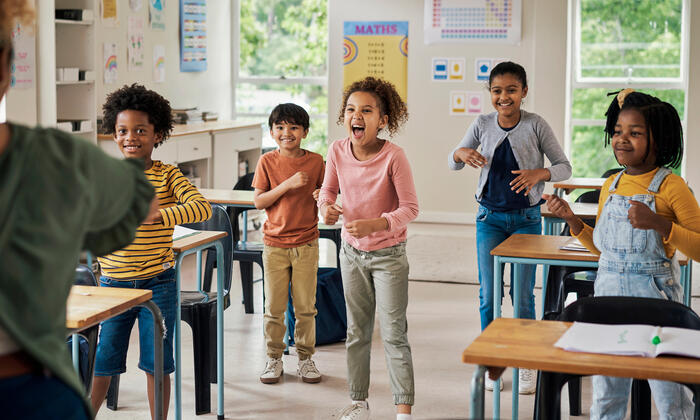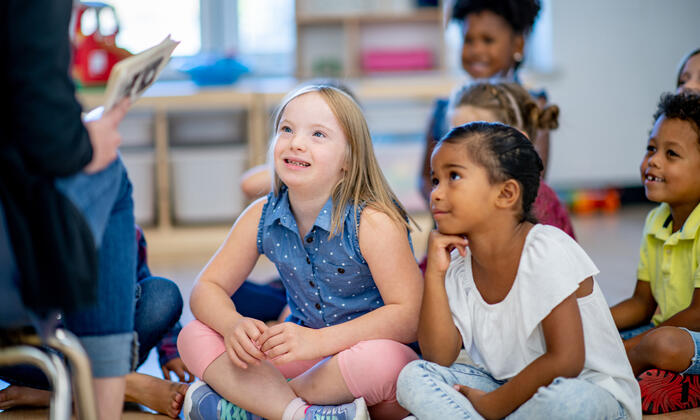Universal Design for Learning (UDL) is an educational framework that aims to make learning accessible to students with a wide range of needs and abilities. By focusing on making spaces, content and learning activities accessible to those with disabilities, UDL can benefit all learners, including those without disabilities. But what does UDL look like in practice, and how can we begin applying UDL to any learning environment?
Universal Design: Changing the Environment
UDL grew out of the idea of universal design in architecture and city planning, where ramps and sidewalk curb cuts, for example, were designed to meet disability support needs but ultimately benefited everyone. Without ramps, people who use wheelchairs were often excluded from public spaces, including schools, or had to rely on individual assistance for access, often via separate, locked, employees-only entrances. By installing a ramp on the main entrance of a building, people in wheelchairs can access the building the same way everyone else does. Ramps also provide easier access for many people who would never have sought or qualified for accommodations, like those who are carrying heavy items or wheeling carts or strollers.
Disability advocates coined the term “the curb-cut effect” to describe how changes made for the purpose of disability access have much broader benefits. Changing the environment to make it more accessible—rather than forcing individuals to adapt to the environment—creates equitable spaces that are more inclusive and provide immediate and practical benefits for everyone.
This focus on reimagining the environment has spread beyond disability activism and helped to shape other movements for equity and social justice. Angela Glover Blackwell, a policy expert and equity movement leader, has promoted “the curb-cut effect” as a model for how programs and policies that center the needs of those who are most underserved—such as people with disabilities and people of color—often benefit the rest of society.
Universal Design for Learning and Disability Justice
The same is true of UDL: All students benefit. Most students don’t have documented disabilities or accommodations; indeed, the diagnosis, assessment and documentation required to secure effective individual accommodations is often out of reach for many families. Yet all students have access needs—some of which are nearly always met by the default systems and processes, and some of which are not. Students whose needs are not usually met by default are “disabled” by the system’s failure to meet their needs. It is the system—not the need—that is disabling. With UDL, careful planning creates systems and processes that meet a greater variety of the predictable needs people have, which normalizes a range of needs and reduces the pressure on students and families to advocate individually.
UDL allows students of varying abilities and disabilities to work together as peers. They learn to understand differences in abilities, needs and strengths, including differences that are not immediately obvious (such as neurodivergent ways of thinking, communicating and perceiving). This understanding will be an asset to them throughout their lives as they experience diverse workplaces and communities and interact with many people whose bodies and minds differ from their own.
By providing students with disabilities with more of the support they need to be successful, UDL also makes it less likely that these students will face disciplinary action because of behaviors that adults don’t understand or needs that aren’t being met. When their needs are met, students are less likely to get caught up in the school-prison nexus that entangles so many disabled young people in a seemingly inescapable web of unmeetable requirements and violent institutions (See The Pedagogy of Pathologization by Subini Ancy Annamma, Ph.D., for more on this cycle.).
UDL does not replace the need for individual accommodations. It is aspirational in being “universal”; in real-world situations, people sometimes have competing access needs, and we should always be prepared to respond creatively and collaboratively to help learners succeed in their own ways. But UDL is far more beneficial, for many more students, than only making individual accommodations.
UDL aligns with a disability justice model that celebrates people as whole beings in all their complexity, assumes that each body and mind has both strengths and limitations, and emphasizes interdependence over individual achievement. Disability justice and UDL both emphasize that learners are different from one another, and that’s okay. Expecting all learners to reach the same objectives on the same timeline is not realistic or just. Expecting the same teaching methods to work for everyone, or expecting students to adapt to educators’ methods, doesn’t work. Instead, we must design learning experiences on the assumption that learners will have different needs from each other.
[Note on identity-first and person-first language: Many disability advocates prefer person-first language (e.g. “person with a disability”) and many others prefer identity-first language (e.g. “disabled person”). Both preferences come from disability advocacy as interventions against ableist implications of language. When talking about a specific person, it's important to use the language that person prefers. For this article—since we are not focusing on a specific identity or person—we’ve used both.]
Toolkit: Universal Design for Learning in Practice
Universal Design: Questions to Consider
From the beginning, UDL invites educators to ask some critical questions as they plan any lesson, course or learning experience. Being intentional about creating inclusive learning experiences is essential.
Some of the questions may be easy to answer, while others will require more creativity and research and the help of additional resources. The following are some questions to consider as educators plan learning experiences:
- What do I know about the diversity of strengths and needs in this group of learners? What don’t I know? How can I find out more?
- For what kinds of learners would this experience (activity, lesson, etc.) work best? Who would find it most challenging and why? What adjustments could I make so everyone can benefit from it?
- What existing knowledge, understanding, skills and capabilities does this activity assume? (For example, does it assume the ability to hear and understand speech quickly? Does it assume the ability to hold several steps of instructions in short-term memory? Does it assume particular fine motor skills?) How could I adapt the activity to make it beneficial for students who don’t have those capabilities?
- How much energy and attention span does the activity require for success? How could I break it down to work for students who may tire more quickly or have shorter attention spans?
- What is the purpose of the activity—not the specific learning objectives, but the bigger “why” behind the learning experience? How can we imagine multiple ways of moving toward that purpose?
The answers to these questions will depend on our context, the age of learners we’re working with, and our own capacities and resources. We must be creative in imagining new ways of doing things, often differently from how we were taught. We have to break out of how things are usually done to notice what else is possible.
Universal Design: Strategies
Below are some introductory examples of UDL practices that can be used in a variety of settings. This is not an exhaustive list but rather a starting point, because there is so much more we can do to design learning experiences that are more inclusive and equitable.
1. Introduce and affirm a variety of communication methods.
With younger students: Explain that we communicate in many ways, and brainstorm together the broad range of communication methods—both those that include language and those that do not. For example: speech, sign language, writing and numbers, typing, a variety of art methods, movement and dance, touch, pointing, ways to indicate choice, expressions, and more. Affirm and provide opportunities to communicate in ways other than speech.
With older students: Introduce a variety of communication methods and ways of responding and participating. Provide opportunities for discussion and participation using a range of communication methods. Technology can provide multiple ways to brainstorm together and have discussions that include those who may be nonspeaking, which can also benefit those who are not comfortable speaking in a group. Explore collaborative technology tools and apps.
2. Provide information in multiple formats.
With younger students: Use a multisensory approach as much as possible. Include activities that engage two or more senses. Use pictures, videos, music and written words, and invite students to move their bodies (in ways that work for them) as they are learning the information. For example, you might have them repeat the information or touch words or pictures. Bring in objects that can be touched or smelled (being cautious to avoid allergens, including perfume and essential oils, and manufactured scents such as scented markers). For all sensory activities, offer choices so that students can avoid becoming overstimulated. Use graphic organizers, charts and drawings as well as spoken instructions. Consider translating information into the languages spoken at home and sharing resources such as multilingual glossaries.
With older students: All the tips for working with younger students also work with older learners, including adults. In addition to recorded media (audiobooks, podcasts, videos), consider integrating self-paced interactive presentations (like web resources that students click through). At the very least, provide information in written and graphic formats in addition to spoken words. Provide individual copies of information in presentations along with transcripts and notes.
3. Provide feedback in multiple formats.
Feedback should be designed to help learners build both competency and positive learning habits, rather than to judge their learning or compare their learning to others’. Like any other information, it should be provided in multiple formats.
With younger students: Give students examples of what success might look like and what learning is building toward, in ways that are relevant to students’ cultures, interests and goals. Give feedback often to help them notice small improvements as well as make corrections. Pair feedback with tools, supports and reminders to help learners improve. In addition to verbal feedback, offer visual representations of progress, such as sticker charts marking progress toward a goal. Visual representations should either be private to each student or should collectively track the group’s learning; they should not publicly compare students’ learning to each other.
With older students: All the tips for working with younger students also work with older learners, including adults (even the sticker charts—adults love getting a gold star!). Additionally, offer learners ways to monitor their own progress, such as templates to guide self-assessment and reflection, checklists, and scoring rubrics.
4. Actively teach strategies for managing attention, time and tasks.
(Many of these strategies are explained in detail in the UDL Guidelines from CAST.)
With younger students: Model the process of setting goals and making step-by-step plans. Provide organizational aids, including graphic organizers and templates, to help learners categorize information and keep track of processes. Model planning by “thinking aloud” about how to approach a task before beginning.
With older students: All the tips for working with younger students also work with older learners, including adults. In addition, provide checklists and note-taking guides, or engage learners in co-creating these resources. Provide estimates of how much time a task should take and encourage students to ask for support if it is taking much longer than expected. Of course, different learners need different amounts of time for the same task—but if a task is taking much longer than expected, it may be an indicator that the task needs to be reframed or reorganized to better support the student’s learning.
5. Encourage multiple ways of participating in discussion.
With younger students: Vary learning formats with a mixture of direct instruction, collaboration in small groups, and individual thinking and practice time. Leave some time for reflection before asking for responses and give students the opportunity to pass and then come back to them. Offer multiple ways to participate nonverbally, including through gestures and technology.
With older students: In addition to the tips above for younger students, it’s particularly important to leave some reflection time before asking for responses and to use formatted questions as well as open-ended questions. Offer ways to participate nonverbally, including the option of turning in short written notes instead of participating aloud. Integrate technology such as Poll Everywhere and similar apps, which allow participants to respond to questions on their phones or devices and let teachers display the aggregated responses.
6. Provide multiple ways for participants to demonstrate learning.
With younger students: A multisensory approach can be helpful when assessing comprehension and growth, as well as in learning activities. Invite students to show what they know in a variety of ways, such as through movement, singing, art-making, writing, storytelling, making choices or indicating answers, and sharing examples that connect with their lived experiences.
With older students: In addition to the above recommendations, it’s especially helpful to provide multiple options for the same assignment. If you would usually assign an essay (but the goal of the learning experience is not primarily essay-writing), let students choose whether to respond in writing, with a voice memo, or in a creative format such as a presentation or artwork (possibly with a brief written artist’s statement).
7. Ask about needs (and do not assume all needs are or can be documented).
With younger students: Lean into curiosity, observe and ask questions. Little kids want to do well, so if something does not seem to be going well, or a student seems disengaged or careless, it might be because they are not able to do the activity in the way it is being presented. Direct and open communication with the child’s family is key in this situation. View caregivers as partners, and together you will be able to figure out the needs of the child and what strategies, services or supports might be needed.
With older students: Older students will tend to have greater awareness of their own strengths and needs, and they should be your first partners in figuring out what will work best for them. Many teachers collect introduction cards on the first day of class, inviting students to share any nicknames, their pronouns and other information they want the teacher to know. This is a great opportunity to ask about access needs. Since many people don’t think of their needs as access needs, the question should be explained and worded in a way that makes sense for the group. To gain insight into their students’ access needs, teachers can use an expanded learning styles inventory that inquires about comfort level in situations and preferred ways to receive information and respond. Provide these questions in a variety of formats and give multiple opportunities for responding to make the inventory, and the act of sharing itself, more accessible.
Getting to know more about learners can be a multistep and ongoing process rather than a one-time questionnaire. Invite student feedback about learning processes and encourage experimentation so that learners can continue to find approaches to learning that work better for them.
The Physical Environment
Infrastructure and environment can support or hinder the learning process. A setting’s acoustics, lighting and temperature, for example, can impact whether that space is comfortable and conducive to learning or not. Even within the practical limitations of our classrooms, small adjustments can make a big difference. Some things to consider:
- A quiet nook for students who might need to self-regulate
- A space where students can move their bodies and get kinesthetic stimulation (e.g., an exercise ball, balance board, or yoga mat with enough space to stretch out completely and move around)
- Different types of seats students can choose from (with and without armrests, of different sizes, both hard and cushioned, with desks/tables of different heights, etc.), distributed throughout the classroom (not marked as “special” seating)
- At least one space with a lighting option that is not fluorescent (also, make sure fluorescents anywhere are not flickering or buzzing)
- Limited unnecessary sounds (electric pencil sharpeners, electronics that ding even as part of a learning activity, decorations that rustle, etc.)
- Spaces designed for independent learning (e.g., desks not facing each other) and other spaces set up for collaborative learning (e.g., chairs in a circle)
- Extra shawls, blankets or oversize sweaters students can use when they feel cold
- Some decorations that are visually interesting but also areas of the room without much visually interesting/distracting material
All students should have access to all the different spaces and ways to use space in the classroom. Students should be able to make choices about using spaces, rather than having some areas available only to students who the teacher thinks need that particular kind of space.
Resources
“Disability Is Diversity” by Courtney Wai
This article emphasizes that embracing diversity means accepting disability as a part of the total human experience and being intentional about practices that remove barriers to learning so all children can thrive.
“Confronting Ableism on the Way to Justice” by Keith Jones
This article contends that to build a society that advances the human rights of all people requires the social justice movement to be intentional in including intersecting identities and diverse equity struggles.
Helping Your Child With a Disability Get a Good Education
These resources for parents and caregivers provide information on educational rights for children with disabilities.
The UDL Guidelines from CAST provide guidance on implementing its Universal Design for Learning framework.
Access Suggestions for Public Events
This guide from Sins Invalid can help organizers consider ways to include people with and without disabilities in public events.
A Planning Guide for Making Temporary Events Accessible to People With Disabilities
This resource from the ADA National Network provides guidance to assist organizers in making temporary events accessible to people with disabilities.
How To Make Your Social Justice Events Accessible to the Disability Community: A Checklist
This resource from Rooted in Rights provides guidance on organizing accessible events.
These resources from the Autistic Self Advocacy Network provide information on accessibility, including recommendations and practices.




0 COMMENTS